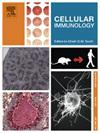Role of CD44+CCR2+CD64−monocyte-derived macrophage in chronic rhinosinusitis with nasal polyps
IF 2.9
4区 医学
Q2 CELL BIOLOGY
引用次数: 0
Abstract
Heterogeneity of monocyte-derived macrophages (MDMs) is gradually recognized in polyp tissue of chronic rhinosinusitis with nasal polyps (CRSwNP). However, the contributions of MDM subsets for sustaining inflammation remain unclear. This study therefore aimed to characterize MDM subsets in polyp tissues and estimate their functions. We identified MDM subsets in polyp tissues by flow cytometry, and analyzed the correlation between the expression of these subsets and disease severity. We also explored the similarities and differences between tissue MDMs and classical ex vivo polarized MDMs. By using appropriate substitutes for tissue MDMs, we investigated the function of MDMs. MDM1 (lin−CD44+CD64+) and MDM3 (lin−CD44+CCR2+CD64−) were identified in polyp tissues by flow cytometry. Recurrent CRSwNP patients exhibited higher levels of MDM3 compared to non-recurrent patients. This increase in MDM3 was positively correlated with the Lund-Mackay score, the number of infiltrated tissue eosinophils, and IL-5 expression levels. Ex vivo polarized alternatively activated (M2a) macrophage preferentially expressed MDM3 marker genes, which can be used as the substitute for MDM3 within the polyp tissues. M2a macrophages engulfed more Staphylococcus aureus than classically activated (M1) macrophages. However, interferon lambda 1 (IFN-λ1) did not alter the bacterial killing efficiency of M2a macrophages, nor did it affect the activation of reactive oxidase substrate (ROS) and signal transducer and activator of transcription 1 (STAT1) pathway and viability. The increase in MDM3 within polyp tissues, similar to classical M2a macrophages, acted as bacterial reservoirs and contributed to persistent inflammation, offering insights into the underlying mechanisms of CRSwNP.
CD44+CCR2+CD64 -单核细胞源性巨噬细胞在慢性鼻窦炎伴鼻息肉中的作用
单核细胞源性巨噬细胞(MDMs)在慢性鼻窦炎伴鼻息肉(CRSwNP)息肉组织中的异质性逐渐被认识。然而,MDM亚群对维持炎症的贡献尚不清楚。因此,本研究旨在表征息肉组织中的MDM亚群并估计其功能。我们通过流式细胞术鉴定了息肉组织中的MDM亚群,并分析了这些亚群的表达与疾病严重程度之间的相关性。我们还探讨了组织MDMs与经典的离体极化MDMs之间的异同。通过选择合适的组织MDMs替代品,我们研究了MDMs的功能。用流式细胞术检测MDM1 (lin−CD44+CD64+)和MDM3 (lin−CD44+CCR2+CD64−)在息肉组织中的表达。与非复发患者相比,复发CRSwNP患者表现出更高的MDM3水平。MDM3的升高与Lund-Mackay评分、组织嗜酸性粒细胞浸润数、IL-5表达水平呈正相关。体外极化交替激活(M2a)巨噬细胞优先表达MDM3标记基因,可作为息肉组织内MDM3的替代品。M2a巨噬细胞比经典激活(M1)巨噬细胞吞噬更多的金黄色葡萄球菌。然而,干扰素λ1 (IFN-λ1)不改变M2a巨噬细胞的细菌杀伤效率,也不影响活性氧化酶底物(ROS)和转录信号转导和激活因子1 (STAT1)途径的激活和生存能力。息肉组织内MDM3的增加,与经典的M2a巨噬细胞相似,作为细菌储存库并促进持续炎症,为CRSwNP的潜在机制提供了见解。
本文章由计算机程序翻译,如有差异,请以英文原文为准。
求助全文
约1分钟内获得全文
求助全文
来源期刊

Cellular immunology
生物-免疫学
CiteScore
8.20
自引率
2.30%
发文量
102
审稿时长
30 days
期刊介绍:
Cellular Immunology publishes original investigations concerned with the immunological activities of cells in experimental or clinical situations. The scope of the journal encompasses the broad area of in vitro and in vivo studies of cellular immune responses. Purely clinical descriptive studies are not considered.
Research Areas include:
• Antigen receptor sites
• Autoimmunity
• Delayed-type hypersensitivity or cellular immunity
• Immunologic deficiency states and their reconstitution
• Immunologic surveillance and tumor immunity
• Immunomodulation
• Immunotherapy
• Lymphokines and cytokines
• Nonantibody immunity
• Parasite immunology
• Resistance to intracellular microbial and viral infection
• Thymus and lymphocyte immunobiology
• Transplantation immunology
• Tumor immunity.
 求助内容:
求助内容: 应助结果提醒方式:
应助结果提醒方式:


